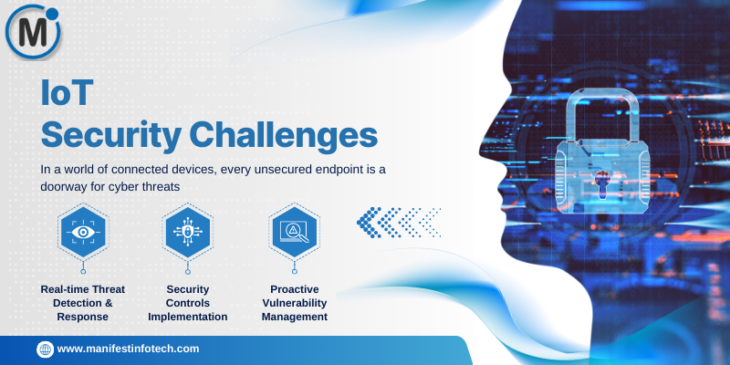
The Internet of Things (IoT) has transformed industries by enabling smart connectivity across devices, enhancing automation, and improving operational efficiency. However, as the number of connected devices grows, so do security threats. IoT security remains a critical concern for organizations and individuals alike, requiring proactive measures to mitigate risks.
Understanding IoT Security
IoT security refers to the measures taken to protect connected devices and networks from cyber threats. Unlike traditional IT security, IoT security involves safeguarding smart sensors, wearables, industrial equipment, and even home automation systems from unauthorized access, data breaches, and cyberattacks.
Major IoT Security Challenges
1. Insecure Devices and Networks
Many IoT devices lack built-in security features, making them vulnerable to cyberattacks. Weak passwords, outdated firmware, and unsecured communication channels expose devices to threats such as hacking and data theft.
2. Data Privacy Risks
IoT devices collect vast amounts of personal and business data. Without robust encryption and secure storage, sensitive information can be intercepted or exploited by cybercriminals, leading to identity theft and financial losses.
3. Lack of Standardized Security Protocols
The IoT ecosystem is highly fragmented, with different manufacturers using varying security standards. This lack of uniformity creates vulnerabilities, making it difficult to implement consistent security policies across devices and platforms.
4. Botnet and DDoS Attacks
Cybercriminals exploit poorly secured IoT devices to form botnets—networks of infected devices used to launch Distributed Denial of Service (DDoS) attacks. These attacks disrupt online services and can cause significant financial and reputational damage.
5. Poor Firmware and Software Updates
Many IoT devices operate with outdated firmware and software, lacking regular security updates. Without timely patches, vulnerabilities remain unaddressed, allowing attackers to exploit weaknesses and gain unauthorized access.
6. Insider Threats and Unauthorized Access
Organizations using IoT must address the risks posed by internal users. Employees or partners with malicious intent can exploit access privileges to manipulate IoT systems, leading to data breaches or operational disruptions.
7. Scalability and Security Integration
As businesses expand their IoT networks, ensuring scalability without compromising security becomes challenging. Integrating security measures across multiple devices and networks while maintaining performance efficiency requires advanced security solutions.
Strategies to Overcome IoT Security Challenges
1. Implement Strong Authentication Mechanisms
Using multi-factor authentication (MFA), biometric verification, and strong passwords enhances access control, preventing unauthorized entry into IoT networks.
2. Encrypt Data Transmission and Storage
End-to-end encryption ensures data security during transmission and storage. Secure communication protocols like TLS/SSL prevent data interception and unauthorized access.
3. Regular Firmware and Software Updates
Manufacturers and users should prioritize regular updates to patch vulnerabilities and enhance device security. Automated updates ensure timely deployment of security fixes.
4. Adopt Network Segmentation
Segmenting IoT devices from critical networks minimizes the risk of widespread cyberattacks. Firewalls, virtual LANs (VLANs), and dedicated IoT security gateways enhance network security.
5. Use AI and Machine Learning for Threat Detection
Artificial intelligence (AI) and machine learning (ML) analyze network behavior to detect anomalies and potential cyber threats. Automated threat detection and response mechanisms improve IoT security.
6. Follow Industry Security Standards
Organizations should adopt standardized security frameworks such as the IoT Security Foundation (IoTSF), NIST IoT Security Guidelines, and ISO/IEC 27001 to ensure compliance and best practices.
7. Enhance User Awareness and Training
Educating users about IoT security risks and best practices reduces human errors. Regular training on secure device usage, phishing threats, and password management strengthens security.
Conclusion
IoT security challenges continue to evolve as technology advances. Organizations and individuals must proactively implement robust security measures to safeguard connected devices and networks. By addressing vulnerabilities, adopting encryption, and leveraging AI-driven threat detection, IoT can be secured against cyber threats, ensuring a safer and smarter digital future.
If you are looking for any services related to Website Development, App Development, Digital Marketing and SEO, just email us at nchouksey@manifestinfotech.com or Skype id: live:76bad32bff24d30d
𝐅𝐨𝐥𝐥𝐨𝐰 𝐔𝐬:
𝐋𝐢𝐧𝐤𝐞𝐝𝐢𝐧: linkedin.com/company/manifestinfotech
𝐅𝐚𝐜𝐞𝐛𝐨𝐨𝐤: facebook.com/manifestinfotech/
𝐈𝐧𝐬𝐭𝐚𝐠𝐫𝐚𝐦: instagram.com/manifestinfotech/
𝐓𝐰𝐢𝐭𝐭𝐞𝐫: twitter.com/Manifest_info
#IoTSecurity #CyberSecurity #DataPrivacy #IoTChallenges #SecureIoT #TechInnovation #NetworkSecurity #AI #MachineLearning #SmartDevices